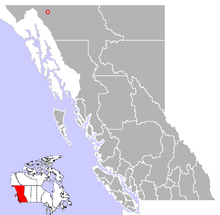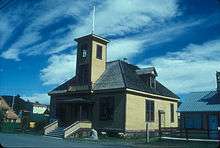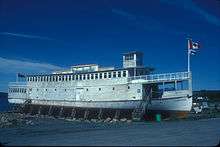Atlin, British Columbia
Atlin (Tlingit: Áa Tlein) is a community in northwestern British Columbia, Canada, located on the eastern shore of Atlin Lake.[1] In addition to continued gold-mining activity, Atlin is a tourist destination for fishing, hiking and Heliskiing. As of 2004, there are 450 permanent residents.


The name comes from Áa Tlein, the Tlingit language word for "big body of water". The surrounding area has been used by Inland Tlingit people for many years and the community is home to the Taku River Tlingit First Nation.
Ever July, the town hosts the Atlin Arts & Music Festival in Tarahne Park. However, the festival did not take place in 2010 nor in 2020.
History

Atlin was founded as a result of a demand for gold mining in the area. The Atlin Gold Rush came to Atlin Lake country in 1898 and was one of the richest offshoots of the Klondike Gold Rush. By the end of the mining season of 1899, around 5,000 people had flocked to the region and Atlin became a busy and important settlement, centre of the Atlin Mining District, and one of the flash-points of the Alaska boundary dispute. Although production was greater in its early years, the Atlin field still produces. Total placer gold production has exceeded $23,000,000.
In the 1920s, Atlin was popular as an exotic tourist destination. There was no road to the settlement, requiring tourists to travel up the Inside Passage through the British Columbia Coast and the Alaska Panhandle and via passes through Alaska and a series of lakes in Yukon and British Columbia. The journey ended when the M.V. Tarahne (and other lake boats) took the tourists across the lake to stay at the large three storey Atlin Inn (built by the White Pass and Yukon Route company). It was during this time it was nicknamed the "Switzerland of the North" because it is surrounded by mountains in much the same way as Switzerland. During the Great Depression, tourism decreased and the White Pass and Yukon Route closed their transportation routes and hotel. Atlin was largely isolated from transportation and commerce until the Atlin Road was built in 1950–51.
Infrastructure
Atlin can be reached via the Atlin Road (Yukon Territorial Highway 7; no number in B.C.) that is maintained jointly by the British Columbia and Yukon governments. At its Yukon terminus, the Atlin Road connects to the Tagish Road and the Alaska Highway (Highway 1). It can also be reached through Atlin Airport. Prior to the 1950 construction of the Atlin Road by the Canadian Army, Atlin was reached overland by two lake steamers, the Tutshi and Tarahne, with a two-mile rail line between the lakes they plied, until the 1930s, then was isolated.
Atlin telephone service is provided by Telus Communications since the independent company serving Atlin was merged into B.C. Tel in the mid-20th Century, and B.C. Tel merged with Telus in 2000. When long distance telephone service was extended to Atlin in 1974, it passed through the territory of Northwestel; an arcane rate agreement between Northwestel and B.C. Tel meant that Atlin residents paid Northwestel long distance rates to and from Whitehorse, plus an additional rate between Whitehorse and Atlin; a CRTC order in the early 1990s forced B.C. Tel to charge its own rates and absorb the cost of passing the calls through Northwestel facilities.
Atlin long relied on a local diesel generator, but hydro power was restored around 2012 with a micro-hydro project near where one historically operated. The output is sufficient for local use, but expansion is being studied, with possible sale of surplus to Yukon Energy Corporation.
Atlin has a radio repeater carrying CBC Radio One, and also has a community-owned television transmitter carrying CBC Television by satellite; when first established, the CBC TV signal was relayed from Whitehorse by a repeater on White Mountain near Jake's Corner.
Climate
Atlin has a subarctic climate (Köppen Dsc) with long, cold winters and short, mild summers. The westerly location and minor Pacific influence, however, makes the winters markedly less severe than in most of northern Canada, and the town is among the northernmost in Canada with a mean annual temperature above 0 °C (32 °F). Precipitation is generally light, with less than 200 millimetres (7.9 in) of actual rainfall per year, and a snowfall less than that of markedly milder Juneau on the coast.
| Climate data for Atlin | |||||||||||||
|---|---|---|---|---|---|---|---|---|---|---|---|---|---|
| Month | Jan | Feb | Mar | Apr | May | Jun | Jul | Aug | Sep | Oct | Nov | Dec | Year |
| Record high °C (°F) | 7.2 (45.0) |
10.6 (51.1) |
14.0 (57.2) |
20.0 (68.0) |
26.7 (80.1) |
31.0 (87.8) |
30.0 (86.0) |
30.0 (86.0) |
26.7 (80.1) |
19.5 (67.1) |
13.3 (55.9) |
10.0 (50.0) |
31.0 (87.8) |
| Average high °C (°F) | −9.1 (15.6) |
−6.1 (21.0) |
−0.3 (31.5) |
6.7 (44.1) |
12.5 (54.5) |
17.2 (63.0) |
19.0 (66.2) |
17.5 (63.5) |
12.3 (54.1) |
5.7 (42.3) |
−2.5 (27.5) |
−5.0 (23.0) |
5.7 (42.2) |
| Daily mean °C (°F) | −12.8 (9.0) |
−10.7 (12.7) |
−5.5 (22.1) |
1.3 (34.3) |
6.9 (44.4) |
11.3 (52.3) |
13.4 (56.1) |
12.4 (54.3) |
8.1 (46.6) |
2.6 (36.7) |
−5.5 (22.1) |
−8.1 (17.4) |
1.1 (34.0) |
| Average low °C (°F) | −16.5 (2.3) |
−15.3 (4.5) |
−10.7 (12.7) |
−4.1 (24.6) |
1.3 (34.3) |
5.3 (41.5) |
7.8 (46.0) |
7.3 (45.1) |
3.8 (38.8) |
−0.6 (30.9) |
−8.4 (16.9) |
−11.2 (11.8) |
−3.4 (25.8) |
| Record low °C (°F) | −47.8 (−54.0) |
−47.2 (−53.0) |
−39.4 (−38.9) |
−31.1 (−24.0) |
−10.0 (14.0) |
−3.9 (25.0) |
−1.1 (30.0) |
−2.2 (28.0) |
−11.1 (12.0) |
−26.7 (−16.1) |
−33.3 (−27.9) |
−50.0 (−58.0) |
−50.0 (−58.0) |
| Average precipitation mm (inches) | 45.6 (1.80) |
25.4 (1.00) |
17.4 (0.69) |
9.4 (0.37) |
18.2 (0.72) |
29.7 (1.17) |
32.8 (1.29) |
34.2 (1.35) |
42.0 (1.65) |
37.4 (1.47) |
36.1 (1.42) |
36.4 (1.43) |
364.6 (14.36) |
| Average rainfall mm (inches) | 1.4 (0.06) |
1.3 (0.05) |
0.5 (0.02) |
3.0 (0.12) |
17.2 (0.68) |
29.7 (1.17) |
32.8 (1.29) |
34.2 (1.35) |
40.7 (1.60) |
27.9 (1.10) |
9.1 (0.36) |
3.2 (0.13) |
201 (7.93) |
| Average snowfall cm (inches) | 44.2 (17.4) |
24.1 (9.5) |
16.9 (6.7) |
6.4 (2.5) |
1.0 (0.4) |
0.0 (0.0) |
0.0 (0.0) |
0.0 (0.0) |
1.3 (0.5) |
9.5 (3.7) |
27.1 (10.7) |
33.2 (13.1) |
163.7 (64.5) |
| Average precipitation days | 12.2 | 8.4 | 7.4 | 3.7 | 8.0 | 9.4 | 10.9 | 11.7 | 12.8 | 12.6 | 11.8 | 12.4 | 121.3 |
| Average rainy days | 0.7 | 0.5 | 0.5 | 1.7 | 7.8 | 9.4 | 10.9 | 11.7 | 12.7 | 9.4 | 1.9 | 1.1 | 68.3 |
| Average snowy days | 11.8 | 8.2 | 7.0 | 2.3 | 0.4 | 0.1 | 0.0 | 0.0 | 0.4 | 4.2 | 10.5 | 11.5 | 56.4 |
| Source: [2] | |||||||||||||
Television
Atlin was featured on the historical television series Gold Trails and Ghost Towns, season 1, episode 9.
References
- "Atlin (community)". BC Geographical Names.
- "Calculation Information for 1981 to 2010 Canadian Normals Data". Environment Canada. Archived from the original on July 1, 2013. Retrieved July 9, 2013.
Further reading
- Dickinson, Christine Frances & Diane Solie Smith (1995). Atlin: the Story of British Columbia's Last Gold Rush. Atlin Historical Society.
- Atlin, 1898-1910. Atlin Centennial Committee. 1971.
External links
| Wikimedia Commons has media related to Atlin, British Columbia. |